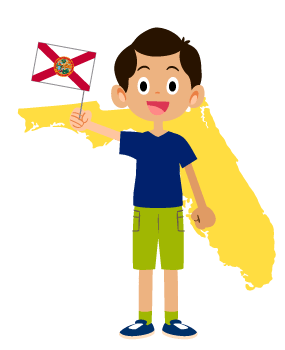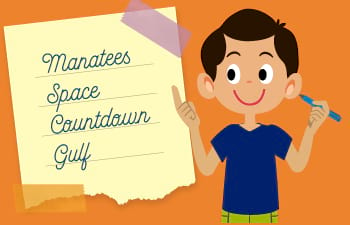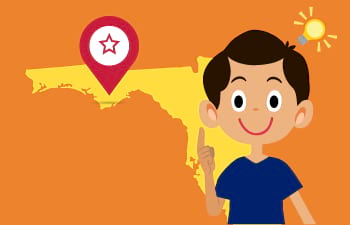The very first region of the continental United States to be explored and settled by Europeans is the area now called “Florida.” Interestingly, though, it was over 300 years before it became the 27th state to join the Union. And that is just one fascinating fact that your homeschooler can learn about this southern state.
This dedicated Florida unit study supplement is part of Time4Learning’s full series of United States unit study supplements. You can also download our list of PreK-12 interactive activities that align with your study of interesting facts about Florida.
Florida Fast Facts
| Became a State | March 3, 1845 |
|---|---|
| Order it Joined the Union | 27th state |
| State Capital | Tallahassee |
| State Abbreviation | FL |
| Border States |
|
| State Flag |  |
| State Song | |
| State Nicknames |
|
| Notable Floridians |
|
Historical Facts About Florida
There were three main native tribes in the Florida territory in its earliest known settled history: the Timucua, the Calusa, and the Apalachee. The first documented Europeans to discover the area were led by explorer Ponce De Leon of Spain. He landed there around 1513 close to what is now St. Augustine. Other Spanish and French explorations occurred throughout the 1500s, and eventually most of the area was claimed for Spain. It was also during this period that the native peoples of the area began to be decimated by diseases that the Europeans carried with them when they arrived.
Following the French and Indian War, the territory of Florida transferred from Spanish to British control. Native tribes from other areas began migrating to Florida territory. They became known as “Seminoles” from the Native American word meaning “outsiders.” When the American Revolution began, Florida actually stayed loyal to Britain and even became a place known to harbor Tories (British Loyalists). At the end of the Revolution, the territory was returned to Spain in the Treaty of Paris.
Spanish Florida began having extreme conflict with neighboring Georgia over Seminole-related issues, that even led to the First Seminole War around 1816-1819. Spain was unable to defend its territory against military invasion by the Americans, so they ceded control of the area to the states in 1821. Many Seminoles remained in Florida, though, until the Treaty of Payne’s Landing, in 1830, promised them the lands west of the Mississippi River if they would leave. Fifteen years later Florida finally was admitted into the Union as the 27th state.
In the timeline below, you can learn more Florida history facts and enhance your children’s online learning experience:
1513
Explorer Ponce De Leon of Spain lead the first Europeans to visit Florida, landing near what is now St. Augustine, Florida.
1539
Another explorer named Hernando de Soto searches near St. Augustine for gold
1565
St. Augustine is established as the oldest permanent settlement in America
1763
Florida becomes a British territory after the French and Indian War
1783
Florida is regained by the Spanish after the Treaty of Paris
1817
The First Seminole war begins after conflict with Georgia
1821
Spain surrenders Florida to the United States, and Florida becomes a territory
1830
The Treaty of Payne’s Landing begins to force out Native Americans to lands west of the Mississippi River
1835
The Second Seminole war begins as a protest from the Native Americans being forced out of Florida.
1845
Florida becomes the 27th state
1860
Abraham Lincoln wins the presidency, despite no votes from Florida
1861
Florida joins the Confederacy after seceding from the Union
1868
Florida is readmitted into the Union
1914
Commercial aviation initiated in Florida when Tony Jannus flew the first passenger service airline from St. Petersburg to Tampa
1958
Fidel Castro takes over Cuba, kicking off a long-term mass exodus of Cubans migrating to Florida.
1961
The first manned space shuttles launched from Kennedy Space Center in Cape Canaveral
1971
Walt Disney World first opens its doors at a cost estimated between 500-600 million dollars.
1982
The Florida Keys “secede” from the United States due to a Border Patrol issue. For about two minutes, prior to surrender, the Key West mayor declared it as the “Conch Republic.”
1986
The Space Shuttle Challenger explodes just minutes after take-off
1992
Hurricane Andrew is one of the most destructive hurricanes that Florida has seen
Geographical Facts About Florida
Florida, the southernmost state in the southeastern U.S., is bordered by both the Gulf of Mexico on the west and the Atlantic Ocean on the east. This is just one of the interesting facts about the Sunshine State’s geography that your homeschooler will find interesting. To enhance your unit study, explore a map of the state and then download our printable Florida map (below) and mark it up with your child. Here’s a small survey of some of the things you and your homeschooler may want note about Florida’s geography and its unique features.
- Florida is the flattest state in the United States with its highest point, Lakewood Park in the southeast, being only 345 feet above sea level.
- Kennedy Space Center, on the eastern coast of the state, has been NASA’s primary launch center for space flight.
- Speaking of Kennedy Space Center, Brevard County, where it is located, has the area code “321” in honor of the countdown sequence that spacecraft experience before liftoff.
- In the northeastern part of the state, the city of Jacksonville is the largest city, by area, in the United States.
- Fort Lauderdale, in southeast Florida, is known as the “Venice of America” due to having over 180 miles of inland waterways.
- No location in the state of Florida is further than 60 miles from a beach.
- More than half of the United States supply of cane sugar is produced in Florida.
- Greater Miami, in southern FL, is the only metropolitan area to encompass two national parks — Everglades and Biscayne.
- Florida’s unique sandy soil and subtropical climate make it ideal for growing citrus fruits. It produces more than 70% of the oranges, tangerines, grapefruits, and tangelos in the entire U.S.
Florida State Map
Download our FREE Florida state map printable. Use it as a coloring page or use it to plot the state’s geographical features.
Activities for Children in Florida
If you homeschool in the state of Florida, you may or may not be aware of all the great day trips that will offer your families opportunities for both recreation and learning. If you are visiting the state, this list will be especially helpful as well. Enhance your Florida facts unit study with these field trip ideas.
- Amelia Island Museum of History (Fernandina Beach) — with a human history dating back to at least the year 1000, Amelia Island is full of stories to tell. The museum houses exhibits that highlight the diverse cultures that have inhabited the area through the years.
- Homosassa Springs Wildlife State Park (Homosassa) — a place where you can view manatees any day of the year from the park’s underwater observatory. The children’s education center offers hands-on nature experiences, and you can take pontoon boat or tram tours through the park as well.
- Kennedy Space Center (Orsino) — whether you are visiting for a special space event, or just to find out what the space center is all about, your homeschooler will never forget this field trip experience. Allow at least a full day for the trip since the center includes a bus tour, a shuttle launch experience, a Journey to Mars experience, and more.
- Pensacola Museum of Art (Pensacola) — located on the campus of the University of West Florida, this museum is focused on modern and contemporary art from the 19th through the 21st centuries. In addition to the permanent exhibits, students will enjoy the ever-changing visiting exhibits as well as ongoing art classes and summer art camps.
For additional field trip options in Florida, visit A2Z Homeschooling’s Florida Field Trips with Kids page.
Florida Freebies and Deals for Homeschoolers
- Brooker Creek Environmental Preserve (Tarpon Springs) — this 8,700 acre preserve offers FREE admission and a chance to experience guided nature tours, educational exhibits, and almost five miles of hiking opportunities.
- Legoland Florida Resort (Winter Haven) — on specific Homeschool Days at the resort, groups of 15 or more can receive deeply discounted tickets with a free chaperone ticket for every ten student tickets.
- Museum of Science and Industry (Tampa) — bring proof of homeschooler status to MOSI to get 50% off a yearly pass for a family of 5. Your pass includes reciprocal admission into 250 science centers around the country, as well.
- Ringling Museum of Art (Sarasota) — on Mondays, the official state art museum for FL, hosting over 10,000 pieces in its collection, offers FREE admission to everyone.













My grandson, which is ten, is having a lot of fun homeschooling with your curriculum! For the first time, he is beginning to use the phrase, “I love reading”. That is so exciting to us!! Thank you for making your videos very engaging and fun!
We are THRILLED to hear this, JoAnn! Thanks so much for stopping by and sharing. We appreciate you being a member of the Time4Learning family! 🙂
Hello Is time 4 learning an actual online school ? if so do you report the students work to the School board for the parents or is that something for the parents to do.
Hi Brittney, thanks for your interest! Time4Learning is a curriculum, not a school. As homeschoolers, the parent is the teacher of record and makes sure to submit any required reporting/testing/information to the school board.
Time4Learning does provide lesson plans and automated reports, to help parents with that. Please don’t hesitate to reach out to us if you have additional questions! https://www.time4learning.com/curriculum/contact_us.php
I appreciate the opportunity to work with my Grandson with the Time4Learning we did Great the first year its a struggle this year but I’m great full it’s here for him to use.
Hi Sheila! Thanks so much for stopping by and sharing. We love hearing from our members and we’re thrilled to know that T4L has been a valuable resource for your family! 🙂
Is there a way to “attach” this to his assigned work, or do I just add it in myself?
Hi Tracey! You would just add that to your student’s schedule outside of any T4L plan. 🙂
this was a fun way for me to learn more about Florida. I advise that you keep this with you at all times so more an more people can learn more about the states
Glad it was helpful for you, Angelina! Thanks so much for stopping by and commenting. 🙂
If this is free we are in for ut